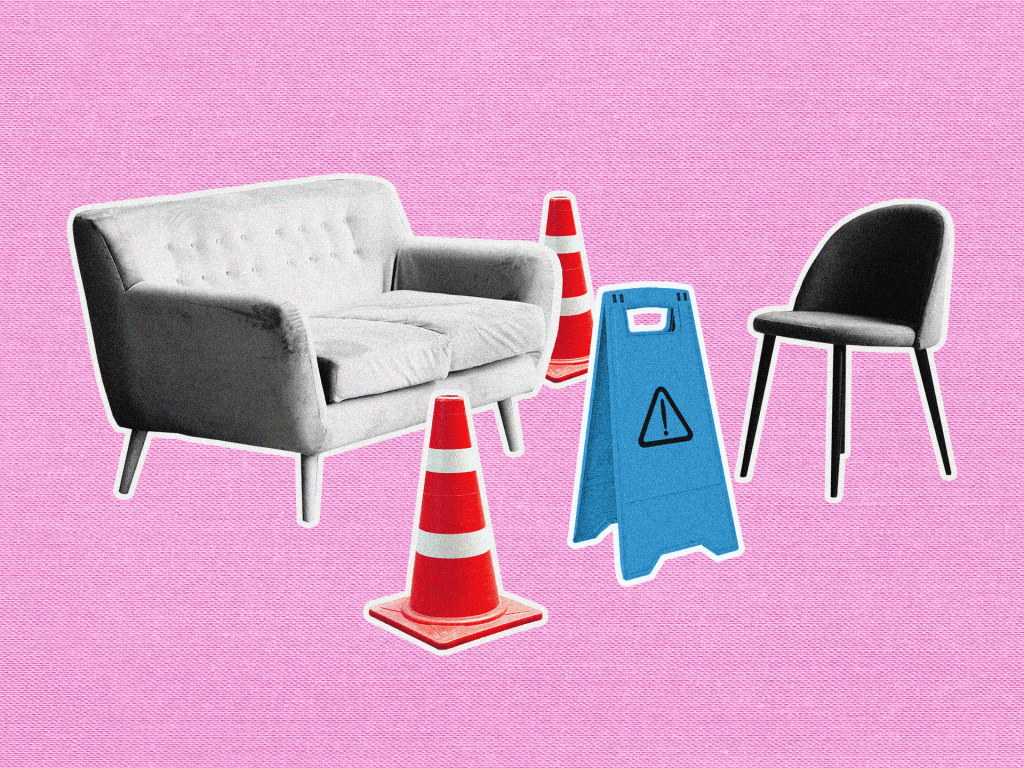Here’s How to Talk to Your Therapist About Suicidal Thoughts and Self-Harm
Because it’s literally their job.
If you or someone you love is struggling with thoughts of suicide, call or text 988 to reach the Suicide & Crisis Lifeline, or chat with someone online at 988lifeline.org.
In theory, therapy is a place where you can word vom your drama, feelings, and hot takes without consequences (I mean, unless you count ~personal growth and healing~). But bringing up your suicidal thoughts or self-harm doesn’t always feel risk-free—and there’s a potentially good reason for that.
The truth is that therapists can break confidentiality and call emergency responders like police, emergency medical services, mental health institutions, or even your own emergency contacts if they believe that you (or others) are in immediate danger, explains clinical psychologist, Jill Harkavy-Friedman, PhD, associate professor of clinical psychology at Columbia University and the senior vice president of research at the American Foundation for Suicide Prevention. What constitutes “immediate danger” kinda depends on the therapist's interpretation (more on that in a sec).
That said, having suicidal thoughts (also known as suicidal ideation) doesn’t always indicate that someone’s in imminent danger, says licensed clinical psychologist Ursula Whiteside, PhD, CEO of suicide prevention organization Now Matters Now. Suicidality exists on a spectrum that includes both active and passive suicidal ideation. “Most people who think about [suicide] will not go on to make a suicide attempt,” says Dr. Harkavy-Friedman. But no matter where your suicidal thoughts fall on this spectrum, they can feel very scary (especially if they’re new), and “they all need to be taken seriously,” she adds.
While this can feel like an incredibly isolating experience, it’s not that uncommon. “[Suicidal thoughts] are more a part of the human experience these days than a huge anomaly,” says Dr. Whiteside. In 2021, about 12.3 million adults in the U.S. thought seriously about suicide, according to a report from the Substance Abuse and Mental Health Services Administration (SAMHSA).
With that in mind, it might be helpful to think of suicidal thoughts similar to a check engine light in your car. “They’re a good indicator that there are things happening in your life that are not OK,” Dr. Whiteside says. Translation: They’re a sign you could use some extra support, like talking to a therapist or any licensed mental health pro. Unfortunately, many people (maybe you?) don’t feel comfortable bringing this up with anyone—even someone who went through years of school to aid people in this exact situation.
Why it’s so hard to talk to your therapist about suicidal thoughts
While part of this could stem from the internalized stigma around suicide, lots of people worry that broaching this subject with a professional will be a one-way ticket to a mandatory hospitalization, explains Dr. Whiteside. Actually, many who didn't reach out before a suicide attempt reported they were concerned about being hospitalized, according to a small study published by Dr. Whiteside and some colleagues in Psychiatric Services.
And this isn’t a totally unwarranted fear. Like we said before, a therapist may need to intervene and break your confidentiality if they think your life or someone else’s is in immediate danger. But that’s not the norm when someone brings up their suicidal thoughts to a doctor or mental health professional, says Dr. Harkavy-Friedman. How it typically works is that a health care provider would first need to understand the extent of your suicidal thoughts, what’s going on in your life that might be adding to or triggering those thoughts, and whether you have the means to carry out a plan to end your life, explains Dr. Harkavy-Friedman. That aligns with the current research-backed standard of care created by the National Action Alliance for Suicide Prevention for treating suicidal ideation outside of mental health care settings.
Of course, “there’s still a good chunk of clinicians unprepared to talk to someone about suicidal thoughts,” says Dr. Whiteside. So, sometimes, even a therapist might avoid bringing up suicide or jump straight into the most extreme response to keep their client safe. “I think fear really interferes with having a useful experience [in therapy], and people are afraid for good reasons,” says Dr. Whiteside. Still, reaching out for help when you’re having thoughts of suicide is recommended—whether you feel safest doing that with a therapist or with a trusted friend or family member.
How to navigate the conversation with your therapist
So, yes, for a lot of reasons it can be tough to broach the topic of suicidal thoughts with a therapist. But being able to safely talk about what you’re dealing with is an important part of getting the support you need. “When we're struggling, we're often not our clearest thinking selves,” says Dr. Whiteside. Having another person to support you and help you feel less alone can make a huge difference. “Sometimes that’s all people need, at least in the moment, to move on, to just not feel so alone and scared or overwhelmed.”
If you’re nervous about sharing your suicidal thoughts with a therapist, here’s what mental health experts say can make that convo go better than you thought.
1. Understand your therapist’s limits.
Ideally, in the first session, your therapist should explain what “immediate danger” means to them and what steps they plan to take if they think you’re in that situation, says Dr. Harkavy-Friedman. They might even ask you to sign a form allowing them to contact someone to provide extra support in case of an emergency, she says.
If you didn’t discuss this with your therapist (or just don’t remember), definitely ask: “Hey, I’m not sure if we’ve covered this already, but can you remind me what your confidentiality limits are?” or: “If I start to talk about suicide or self-harm, what happens next? What would you have to do?”
If you don’t want to ask bluntly, you can try something like, “I read a news story about suicidal thoughts being really common. How do you talk to your clients who are having those thoughts? What happens in that situation?” explains Dr. Whiteside.
However you phrase it, the goal is to find out what they would feel obligated to escalate (and who they would contact), what situations would make them immediately concerned for a patient’s safety, when a psychiatric hold would be a possibility, and what that escalation process looks like for adults (or minors, if that’s you). That way, you have a better understanding of the process and can disclose—or not—what you’re going through while feeling more in control of what happens next.
And if you get the sense that the therapist isn’t comfortable talking about suicidal ideation in general, it might be time to find a mental health pro who is, adds Dr. Harkavy-Friedman.
2. Be straightforward and specific.
There’s no perfect time or place to broach this topic, says Tola T’Sarumi, MD, a board-certified psychiatrist and addiction specialist. So if your therapist passes the vibe check, that’s your sign to get right into it, being as direct as you can, she adds. Start with something like, “I’ve been having these thoughts and they make me uncomfortable,” or “I’ve been feeling like I don’t want to live anymore,” she suggests.
Therapists will typically have follow-up questions to understand the scope and severity of what’s going on, like if you’ve made a plan or have access to things that will harm you. By being fully honest, you’re giving the therapist a clear indication of where your suicidal ideation falls on the scale. Plus, that self-awareness could indicate that you’re open to their ideas and support and willing to help them help you, explains Dr. Whiteside. That’s more evidence they can use to determine whether you’re actually an immediate danger to yourself or others.
Again, what “immediate danger” means varies by practitioner, but to Dr. Whiteside, “imminent risk means that they have a plan to harm themselves in the next 24 to 48 hours and that they are unwilling or unable to delay suicide or work with others to keep themselves safe,” she explains. “There isn't something that they're willing to do or able to do to prevent themselves [from acting on these thoughts]."
3. Tell your therapist what they can do to be most useful.
Being clear about your needs and expectations can help your therapist show up in whatever way is best for you. Before your session, think about what you want from this time and just tell them. That could look like normalizing what you’re going through, giving you some context as to what the hell is happening, creating a safety plan just in case your thoughts get more severe (or already are), or getting to the bottom of what might be triggering the thoughts in the first place—like depression or money struggles.
Dr. Whiteside says most people she’s talked to about their suicidal ideation just want their therapist to be a calm source of hope who’s present with them and their feelings.
4. Be open to their advice.
Honestly, these conversations can be really difficult, even with a therapist you know well. But it’s their job to navigate these circumstances with you, says Dr. T’Sarumi. While you might not agree with everything they suggest, a willingness to try new strategies or work together in a different way can be really helpful.
Also, that really helpful strategy might just be inpatient treatment and/or an emergency hold. Yep, the idea of that can feel really scary, but these measures ensure that you’re out of harm’s way until the immediate crisis has passed and you’re in a better mental state, says Dr. Whiteside.
Keep in mind that being defensive or shutting down isn’t super useful for you, and it might make your therapist more worried about your well-being, says Dr. Whiteside. They may wonder if you might be in the middle of an imminent crisis. To be clear, you shouldn’t gloss over or fake what you’re feeling, but being open with your therapist can get you the care that you need, Dr. Whiteside says.
5. Make a safety plan together.
A safety plan is basically an in-case-of-emergency document you create with an assist from a mental health pro and anyone else you trust. When things get rough, you and the people who have your back can use this to ensure you’re as safe as possible until the crisis passes, says Dr. Harkavy-Friedman.
Again, you should work with a licensed therapist to create this doc but here’s what this could look like. First, start by identifying any triggers or warning signs that typically accompany a spike in your suicidal thoughts, says Dr. Harkavy-Friedman. That might look like getting less sleep, feeling more irritable, or withdrawing from your people.
Then, you’ll jot down coping strategies you can do on your own to feel a little relief. This could include breathing exercises, light movement, making time for an art project, or watching your favorite comfort shows. This should be stuff you actually enjoy or find helpful, says Dr. Harkavy-Friedman. Writing down a list of all the things you’re grateful for or things worth living for (big or small) can also be beneficial to review when you’re in a crisis, says Dr. Whiteside.
Next, make a list of two sets of people: folks who can distract you (meet you for coffee or take you to do something fun) and others you can talk to about what’s going on. “You can literally just list people and their contact information,” says Dr. Harkavy-Friedman. You’ll also want to make a list of your “in case of an emergency break glass” type of contacts, like your therapist, the number of a local hospital, and the Suicide & Crisis Lifeline via their easy-to-remember number 988 (you can text the hotline too).
Finally, limit your access to anything that could be a danger to you when you’re experiencing suicidal thoughts, like firearms or substances you might misuse, says Dr. Harkavy-Friedman.
Once you’ve established your safety plan and shared it with the relevant people, check in with it every so often to make sure all the info is up to date, says Dr. Harkavy-Friedman. Otherwise, bust it out whenever you’re starting to notice yourself struggling.
Wondermind does not provide medical advice, diagnosis, or treatment. Any information published on this website or by this brand is not intended as a replacement for medical advice. Always consult a qualified health or mental health professional with any questions or concerns about your mental health.




